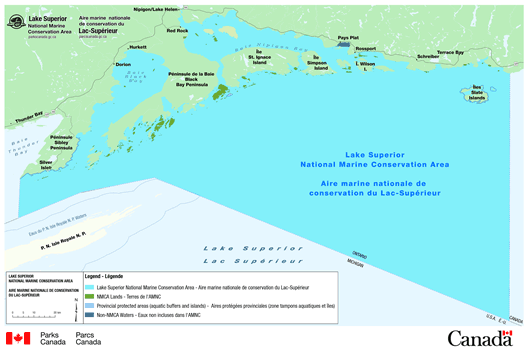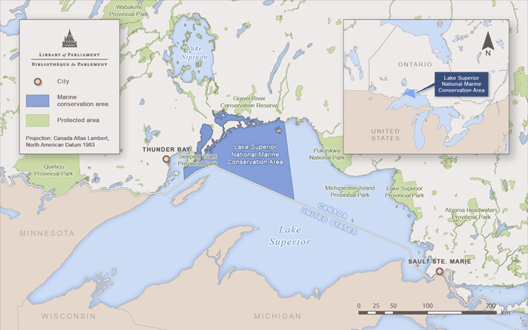Any substantive changes in this Legislative Summary that have been made since the preceding issue are indicated in bold print.
Bill C-61, An Act to amend the Canada National Marine Conservation Areas Act (short title: Lake Superior National Marine Conservation Area Act) was introduced in the House of Commons on 2 June 2015 and received third reading on 17 June 2015.
The bill amends the Canada National Marine Conservation Areas Act1 to establish the Lake Superior National Marine Conservation Area (NMCA) of Canada near Thunder Bay, in Ontario. Under the Act, Parks Canada is required to manage its NMCAs “for ecologically sustainable use with protections ensured through different types of zoning in the [NMCA].”2
“National marine conservation areas are established to conserve and protect representative examples of Canada’s oceans and Great Lakes” and “provide opportunities for the ecologically sustainable use of aquatic resources.”3 According to a government backgrounder, national marine conservation areas “consist of protected zones and cooperatively managed multiple use areas where activities such as commercial fishing and shipping continue [but d]umping, mining, oil and gas exploration and extraction are prohibited.”4
The Lake Superior NMCA “is the world’s largest freshwater protected area with a surface area of over 10,000 square kilometres.”5 Its proposed area “extends from Thunder Cape at the tip of Sleeping Giant Provincial Park in the west, to Bottle Point just east of Terrace Bay, and out to the Canada–U.S. boundary. It includes the waters of Black Bay and Nipigon Bay.”6 The conservation area contains habitat for many species, including peregrine falcons, loons, woodland caribou, trout and pickerel.7
Parks Canada follows a five-step process to establish an NMCA.8 After having completed the first three steps, the federal government, as part of step 4, signed a Memorandum of Understanding (MOU) with the Province of Ontario regarding the possibility of establishing an NMCA in Lake Superior.
In 1998, the minister responsible for Parks Canada appointed a regional committee of Lake Superior stakeholders, comprising members of communities on the north shore of the lake, First Nations, and resource users, to explore the feasibility of establishing an NMCA.9 In 2001, the regional committee submitted its recommendations, endorsed by an independent review committee, to Parks Canada, and proposed that the federal agency proceed with an NMCA. Based on this feasibility process, in 2002, Parks Canada presented to the public its vision for the NMCA.
After Parliament passed the Canada National Marine Conservation Areas Act in 2002, the federal government and Ontario began negotiating to reach an agreement confirming the transfer of the lakebed and selected islands within the proposed Lake Superior NMCA from the province to Canada.10 A memorandum of agreement11 (MOA) was reached in 2005 and signed on 25 October 2007, along with a Parks Canada–Northern Superior First Nations Protocol regarding the role of area First Nations in the management of the proposed NMCA.
A “condition precedent” in the MOA states that:
Ontario will not transfer the Lands or Lands Under Water in the Marine Conservation Area to Canada until an agreement can be made, as contemplated, in the Side Agreement … that ensures Ontario will retain jurisdiction, management and control of the taking of water located in the Marine Conservation Area after the Lands and Lands Under Water have been transferred to Canada.12
This condition precedent is consistent with Ontario’s obligations under the Great Lakes–St. Lawrence River Basin Sustainable Water Resources Agreement,13 which it signed with U.S. Great Lake states and Quebec in 2005.
Accordingly, on the same date that the MOA was signed, a side agreement to the MOA regarding control over potential water takings within the NMCA was signed. That side agreement states:
Ontario will retain jurisdiction, management and control over the taking of water located within the National Marine Conservation Area in western Lake Superior after the transfer of lands and lands under water has been made in order to enhance and further promote environmental protection in western Lake Superior.14
Following the 2007 agreements, Parks Canada conducted further public consultations and worked on developing an interim management plan, required under the Canada National Marine Conservation Areas Act, guiding the first five years of operation of the NMCA and containing management objectives and a zoning plan.15
Bill C-61 represents the final step in establishing the Lake Superior NMCA, formally designating the conservation area under legislation and allowing zoning regulations16 to be enacted and enforced to protect it.
Sections 5 and 7 of the Canada National Marine Conservation Areas Act set out the ordinary means by which an NMCA is established. The Governor in Council issues an order that the name and description of the NMCA be added to Schedule 1 of the Act, and the order is laid before each House of Parliament along with a report. The report must include information on consultations undertaken, agreements reached, results of assessments of mineral and energy resources undertaken, and an interim management plan for the NMCA.
The Lake Superior NMCA of Canada is being established through an Act of Parliament (Bill C-61) rather than through an order. The bill must amend other sections of the Act to make Ontario provincial laws related to water takings apply to the NMCA, as stated in the side agreement.
Bill C-61 amends the Canada National Marine Conservation Areas Act for two purposes:
The Canada National Marine Conservation Areas Act is structured to set out general provisions relating to NMCAs, followed by schedules listing each NMCA or reserve along with its description.17 This structure is similar to that of the Canada National Parks Act,18 which lists all the national parks and park reserves in schedules to the Act.
To date, there is only one NMCA reserve listed in Schedule 2 of the Act: Gwaii Haanas National Marine Conservation Area Reserve and Haida Heritage Site. Clause 4 of the bill adds the Lake Superior NMCA of Canada, along with its description, as the first NMCA in Schedule 1 of the Act. Clause 4 comes into force (meaning that the NMCA is established) on a day to be fixed by order of the Governor in Council (clause 5).
Figure 1 shows the waters and lands included in the Lake Superior NMCA. Figure 2 shows the approximate location of Lake Superior NMCA within Lake Superior.
Figure 1 - Lake Superior National Marine Conservation Area of Canada

Source: Parks Canada, “Lake Superior National Marine Conservation Area,” Backgrounder, 2 June 2015.
Figure 2 – Approximate Location of the National Marine Conservation Area Within Lake Superior

Source: Map prepared by the Library of Parliament using the following materials: Natural Resources Canada, Atlas of Canada – Base Maps Scale 1:2,000,000 – Ontario; and Canadian Council on Ecological Areas, Conservation Areas Reporting and Tracking System Database (see CARTS Introduction).
Bill C-61 adds a new section to the Act stipulating that Ontario laws concerning “water taking” and “water transfer” apply within an NMCA in Ontario.19 Such provincial laws include the Ontario Water Resources Act, the Environmental Bill of Rights and regulations made under these Acts (clause 2, adding new sections 7.1(1) to 7.1(3) to the Act).
The term “water taking” is described in the Ontario Water Resources Act20 as including taking water by means of:
Under section 34 of that provincial Act and subject to exceptions, a permit is generally required to take more than 50,000 litres of water on any day.
The term “water transfer” is also described in the Ontario Water Resources Act. The Act prohibits taking water from a water basin, such as the Great Lakes–St. Lawrence River Basin, and transferring the water out of the basin. The prohibition is subject to various exceptions. The Act also regulates the bulk transfer of water from one of the five watersheds within the Great Lakes–St. Lawrence River Basin to another watershed within the same basin.
Bill C-61 includes various provisions clarifying that:
* Notice: For clarity of exposition, the legislative proposals set out in the bill described in this Legislative Summary are stated as if they had already been adopted or were in force. It is important to note, however, that bills may be amended during their consideration by the House of Commons and Senate, and have no force or effect unless and until they are passed by both houses of Parliament, receive Royal Assent, and come into force. [ Return to text ]
© Library of Parliament